
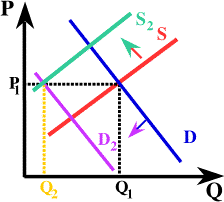
Once society determines that a substance is illegal, it becomes the job of law enforcement to arrest those who produce, sell, and use the substance. The long run intent of these activities is to reduce overall consumption of the substance. The idea is that by arresting those involved, supply will be curtailed, and others who might consider becoming involved either as suppliers or users are dissuaded because they realize that their eventual arrest is likely. The graph to the left illustrates this as a shift back in both supply and demand. As we know, such simultaneous shifts are bound to reduce quantity so if this is how things work such busts should be very effective at reducing the use of illegal drugs.
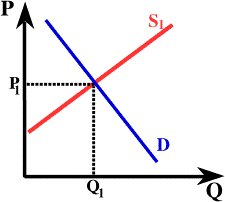
Authorities have been arresting drug dealers and seizing manufacturing and/or growing operations for many decades and the problem doesn't seem to go away. There are many possible explanations for the persistence of drug problems and we can't investigate even all the possible economic reasons here, however we can consider one possible scenario. Suppose the graph to the left illustrates the market for some illegal drug in equilibrium prior to a major bust.
S1 is the supply of the illegal substance, like any other supply curve it is upward sloping indicating that rising prices will induce producers to provide more of the substance. Likewise we have to suppose that the inducement for drug suppliers is profit, if profits increase suppliers will enter, if profits decrease suppliers will exit.
Apart from the fact that the production and sale of the substance is illegal, entry is probably not difficult. In the case of methamphetamine, laboratories seem to be relatively easy to set up as they appear all over the US. In general, supply shortages of illegal drugs are usually short lived. If entry is fairly easy the supply is very elastic in the long run. Here the long run is probably a matter of weeks or months depending on the drug and how it is produced.
Demand for such substances is usually expected to be quite inelastic, if for no other reason because many illegal substances are addictive (like the legal substances caffeine, alcohol, and nicotine) or may lead to a psychological dependency.

A major seizure of drugs will, in the short run, reduce the supply of drugs that are available for sale. We've illustrated this to the right by SSR (short run supply) which we show as perfectly inelastic in the period immediately following the arrests. This sudden shortage quickly leads to a rapid increase in the price of the drug to P2 and a reduction in quantity used to Q2.
In the short run the bust seems to be very effective. Producers are put out of business and presumably punished, and consumption of the drug is greatly diminished. But what about the suppliers who weren't arrested? Suddenly their product is worth far more than it was before and they reap large unexpected profits. It may turn out that the real beneficiaries of a drug bust are the dealers who weren't busted. What happens next in our version of the story?
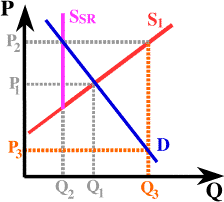
Several stories can be told about whether the supply curve will actually shift back due to the publicity surrounding the bust and the change in potential dealers beliefs about possible arrest, or shift out due to the increased profits being realized by those not busted. For now lets just assume that new dealers and producers will appear to replace the old so that we have the same long run supply curve as in the graph to the left. If so, notice that this leads to a large increase in output to Q3 once production is able to start up again. (This effect can occur in legal agricultural markets too, a bad season leads to high prices which leads to overproduction next season.) Once output Q3 is produced, street price has to fall all the way to P3 in order to clear the market. In short, some weeks or months later the bust has inadvertently lead to a period of cheap, plentiful drugs, exactly the opposite of what was intended.
The story isn't over yet. Clearly P3, Q3 isn't an equilibrium since desired quantities supplied and demanded aren't equal. If all stays as it is in the graph above the market will return to its original equilibrium, however there is another, more worrisome, possibility.
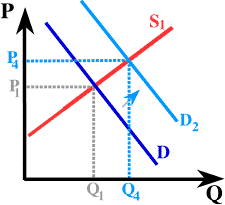
We've learned that a change in market price doesn't shift demand, it simply causes movement along the demand curve. However, drugs are an unusual commodity. Perhaps as a result of the period of cheap, plentiful drugs more people will become dependent on the drug, or the amount needed to satisfy current users increases. In either case, the demand could shift out to D2, as shown to the right. If so, the equilibrium price would rise to P4, and equilibrium quantity would increase to Q4. (Its easier to shift out demand for an addictive substance than it is to shift it back again, one of the problems in attempting to curtail the use of illegal drugs.) If this is the end the drug bust has lead to higher consumption, output and prices. But our story isn't over yet.
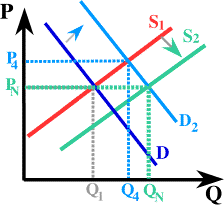
What if dealing drugs is a relatively easy industry to enter? In that case a higher equilibrium price will mean greater profits for existing producers and long run entry. If so we might end up with a supply shift to S2, as shown to the left. In this case the long run effect of the policy ends up being, unintentionally of course, to actually increase drug consumption beyond Q4 all the way to QN, lower the price back to PN, and to increase the size of the industry. The new long run equilibrium has more users, more producers and more consumption than prior to the bust.
Our story may not be true, indeed its probably an extreme case of what might happen. Even if it is true we aren't suggesting that law enforcement give up. If no one is ever arrested this too will shift out demand and supply as the belief grows that laws aren't enforced. Our intent here is to illustrate that the economic consequences of policies, even something as seemingly clear as a drug bust, may not be as simple as initially expected and may lead to very different, even highly undesirable results. Whether our story is right or wrong, curtailing illegal drug use is very difficult.
Our story here depended on a set of assumptions that may or may not be correct. A useful exercise, indeed an excellent exercise, is to figure out which assumptions were critical in making this story work out as it did.
Another useful exercise is to use your economic reasoning to come up with socially feasible alternative policy recommendations for reducing the use of illegal drugs.
The following are some of the crucial assumptions that allowed our little scenario to play out as it did.
Copyright © 1995-2003 OnLineTexts.com, Inc. - All Rights Reserved